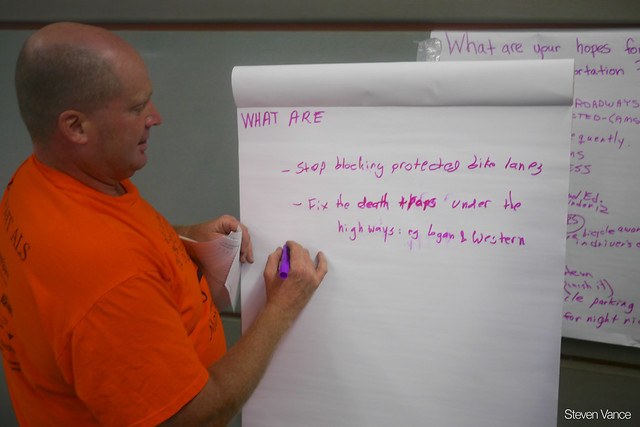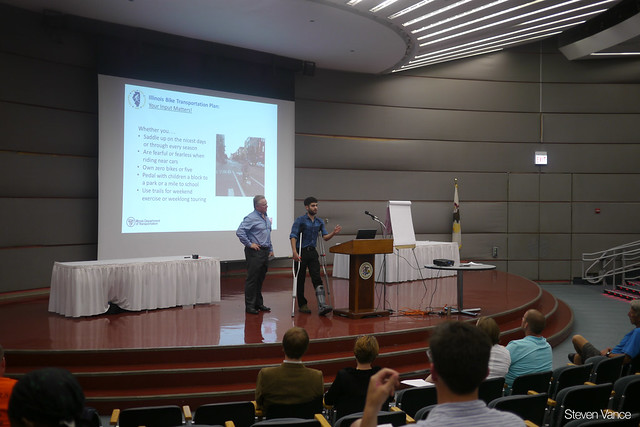At a public meeting about the first state bike plan last night, staff from the Illinois Department of Transportation said the agency is trying to change its culture, and that starts with separating the bicycle component from its Long Range Transportation Plan into its own planning process. With about 70 participants in the crowd at an auditorium in the Thompson Center, IDOT and its consultant, Alta Planning + Design, explained how the bike plan will be developed, led two public input exercises, and fielded questions.
The first exercise asked attendees to think about how "to achieve a future where a broad range of people use bicycles for a broad range of reasons in a broad range of places in Illinois." After several people shared their ideas, Alta staffer Jack Cebe walked through a survey that attendees picked up on the way in (parts of which you can fill out online), asking participants why they bike and what "policies, programs, and projects" – and infrastructure – would encourage them and their friends to bike more often.
A risk with this type of survey is that it will overemphasize what people who already bike want to see happen, instead of focusing on treatments that are proven to be safe and appealing to the broadest possible range of people, including those who don't currently bike. For instance, it asks if you would bike on a four-to-six-lane road if a different kinds of bike infrastructure were added (including protected bike lanes), if were left as-is, or if you might never ride on it regardless of the treatment. Since the people in the room already bike, this doesn't necessarily provide a good sense of what would make the average person more comfortable biking on Illinois streets.
As it happened, several people who showed up last night did express strong interest in protected bike lanes. When Cebe finished explaining the survey, attendees launched right into interrogating IDOT about its ban on protected bike lanes on roads under its jurisdiction (like Jackson east of Ogden, the first proposal from the City of Chicago that IDOT blocked, or on Elston north of Armitage). Annie Adams, who bikes from Andersonville to the Loop year round, asked, "Why does the Illinois Department of Transportation oppose the Mayor's protected bike lane plan?
Gabe Sulkes, a bicycle and pedestrian policy advisor at IDOT who recently broke his leg in a bike crash, replied, "IDOT does not oppose the mayor's protected bike lane policy or any policy. We support the collection of data and safety data in particular to ensure that we develop safe and sustainable accommodations for all users."
When I asked Gabe if protected bikes were unsafe, he started off by saying, "What the state is doing... is allowing enough data to be collected so the state can make informed --" but was interrupted when someone asked, "How long does this collection take place?" Another attendee piped in, asking, "How can we make this go faster?"
I won't inundate you with the whole play-by-play. But it's worth noting that the IDOT reps did seem to be listening attentively to the attendees and noting their concerns.
Jane Healy, a school district board member in Blue Island and leader of Cal-Sag Cycles, said she was concerned that IDOT is saying one thing, but doing another. She cited the example of a roadway widening project outside Blue Island High School -- most people walk or bike to the school, but IDOT isn't building a sidewalk. "Can we have actual implementation of the Complete Streets policy?" she asked.
It was apparent that people don't understand, don't believe, or don't accept IDOT's reasoning for banning protected bike lanes. The IDOT reps responded from their handbook on this one, but at least they heard from people who hadn't had the chance to talk to state officials about this very important safety issue before.
In response to attendees' complaints and concerns about the protected bike lane ban, IDOT representatives stated again and again that the agency is trying to change its standard operating procedures. Bola Delano, the department's deputy director of planning and programming (former deputy executive director at the Chicago Metropolitan Agency for Planning) said, "We used to focus only on highways...you're right, but we have been given direction to focus on all modes. We're trying as a department to move away from old cultures."
Like many a public meeting, this one didn't represent everyone who lives in the city and region. Adrian Fisher, the sustainability coordinator at Triton College in River Grove, asked, "I'm not seeing a lot of folks. Are you going to be interviewing individuals on a more granular level?" Fisher is concerned about how students can bike to school.
Getting a wider variety of participants will be the most important issue for IDOT and Alta to address. Reader Justin Haugens commented on John's post about the bike plan meeting for transportation professionals that administering the survey to attendees was unnecessary, because they were not novice cyclists. "What needs to be done is to pass the survey along to friends, family, acquaintances to increase the input the state receives," he wrote.
IDOT expects Alta to provide a series of recommendations and action items in December, addressing what the state's bike policies should be, what to change about its design standards, and how to handle maintenance, funding, and education issues. But without expanding the scope of the outreach, the plan may fail to understand what people in Chicago and its suburbs need in order to ride a bicycle for work and shopping trips, or to encourage people to start bicycling for transportation.






